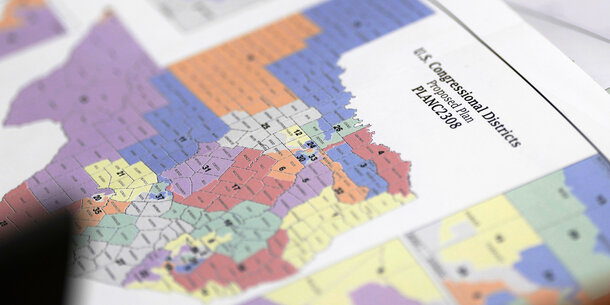After more than a decade of fighting for politically balanced maps, Wisconsin voters finally achieved victory last month. The legislature passed new maps that ended one of the country’s most aggressive gerrymanders and put control of the state assembly and senate in play for the first time since 2010 by creating a map that allows both parties a fair chance to win a majority in the state assembly.
The battle for fair maps reached its quick and somewhat surprising end in December 2023, when the Wisconsin Supreme Court found the state’s legislative districts unconstitutional because so many of them were not contiguous. In the majority opinion striking down the maps, Justice Jill Karofsky noted that “the number of state legislative districts containing territory completely disconnected from the rest of the district is striking. At least 50 of 99 assembly districts and at least 20 of 33 senate districts include separate, detached territory.”
The court required districts to be redrawn to be contiguous, equally populated, and in compliance with Section 2 of the Voting Rights Act, which prohibits diluting the votes of minority communities. Additionally, recognizing that it might have to serve as the map drawer if the state’s Democratic governor and Republican-controlled legislature were unable to agree on a map, the court ordered that any remedial map passed under its watch be politically neutral. It explained that “unlike the legislative and executive branches, which are political by nature, this court must remain politically neutral. We do not have free license to enact maps that privilege one political party over another.”
To prepare for the possibility of legislative deadlock, the court began a parallel remedial process in which the parties to the case and other stakeholders could submit proposals for review by two court-appointed impartial experts known as special masters. The state’s Republican-controlled legislature, the Democratic governor, a group of Democratic state senators, and all the three groups of petitioners and interveners in the case (two groups of Democratic voters known as the Clarke petitioners and Wright intervenors, respectively, and the Johnson intervenors, a group of Republican voters) all submitted map proposals.
After review, the special masters issued a report finding that proposals submitted by the Republican-controlled legislature and the Johnson interveners were substantial pro-Republican partisan gerrymanders that should be excluded from consideration. The special masters found that the four remaining proposals complied with the standards set forth by the court.
But just when it appeared that judges would select Wisconsin’s new legislative map among the remaining live proposals, the state legislature made a surprising about-face and quickly passed the plan proposed by the governor without any changes. Gov. Tony Evers signed the maps into law on February 19.
Partisan Fairness
One way to think of political fairness in redistricting is to determine if one political party is securing more seats than we might expect based on the share of the vote the party’s candidates won at the polls. A map is presumptively not neutral if the measure of seats tilts significantly toward one party beyond what its electoral performance might suggest. Of course, map drawers may be able to show that a fairer map was not possible within the constraints imposed by map-drawing rules.
Some states explicitly use this type of proportionality standard for fairness. For example, the Ohio Constitution’s Article XI, Section 6(B), includes a standard relating to votes and seats that is helpful when evaluating the performance of a proposed district plan, stating, “the statewide proportion of districts whose voters, based on statewide state and federal partisan general election results during the last ten years, favor each political party shall correspond closely to the statewide preferences of the voters of Ohio.” In other states, similar, if not identical, standards are used under more general principles of political neutrality, such as constitutional guarantees of free and equal elections or state equal protection clauses.
In Wisconsin, there are 13 statewide contested elections between 2016 and 2022 that an evaluator can use to determine how typical Democratic and Republican candidates would fare in every district under the six proposals. Using these statewide election results, it is possible to calculate how each district in a map would perform under a range of reasonably foreseeable election scenarios and to measure, for each election cycle, how close each map would have come to overall proportionality.
Wisconsin is consistently a very competitive state: Democratic candidates in all 13 of the examined statewide elections won just 50.8 percent of the two-party vote. In those elections, Democrats’ best performance was 55.4 percent of the vote, received by Tammy Baldwin in the 2018 U.S. Senate race, and the worst performance was 48.3 percent, received by Russ Feingold in the 2016 U.S. Senate race.
These two charts below help establish the likely range of a plan’s outcome from strong Democratic (or weak Republican) years to weak Democratic (or strong Republican) years.
The figure above shows how these six proposed assembly plans stack up on the seats-and-votes approach to partisan fairness. The two vertical lines indicate the high and low number of assembly seats the Democratic share of the vote would produce where the party’s share of seats closely tracks their share of the popular vote. The governor’s plan falls in the middle of the set of proposals, but just above the low end of the range of neutral outcomes.
The figure below shows the result is similar with respect to state senate seats. Governor Evers’s plan would create one fewer Democratic district than the minimum number of seats we expect based on the 2016–22 elections, far closer to proportionality than Republican proposals.
Electoral Responsiveness and Neutrality
Another way of assessing neutrality is to consider how sensitive or responsive a district map is to shifts in sentiment from the electorate. Gerrymanders tend to block one party from securing a majority because the map is designed to consistently deliver advantages to the favored party even if the electorate moves strongly against the favored party. For example, under the legislative map put in place by Wisconsin Republicans after the 2010 census, Republicans would win a near supermajority of state house seats by winning just 48 percent of the two-party vote.
Using the same set of statewide elections between 2016 and 2022, we can assess the sensitivity of a plan by estimating the statewide vote share needed for either party to win any assembly district. Taking these estimates as a whole, it is possible to produce a seats and votes curve that captures the relative electoral pressure needed to improve the number of seats that a party enjoys in the legislature.
Governor Evers’s assembly plan is a major improvement over the map that was in place for the 2022 elections. In the earlier map, we estimated that Democratic candidates would need to win 57 percent of the statewide vote to win a majority of the assembly — a level far exceeding the best Democratic performance of recent years. This plan also reduces the number of swing districts either party could win. We estimate there are only five seats that fall in the competitive 48–52 percent band of statewide vote share. As we show in the figure above, however, winning all those competitive seats would not determine the majority in the assembly. Rather, the 2022 plan makes a Republican majority a given.
By contrast, under the governor’s plan, Democrats will likely win a majority in the assembly if the party wins 52.1 percent of the statewide vote — a realistic outcome based on Democrats’ performance in recent past elections. The map also draws seven seats in the band between 48 and 52 percent of the electoral vote, suggesting this new map will do a better job of giving effect to a majority of the votes cast for a party to produce a majority of the assembly for that party. An important measure of the responsiveness of this plan is that all seven seats fall within this band of competition between the parties. It is possible for either party to win a majority in the assembly under this map, in line with the perennial battleground state politics of Wisconsin.
Contiguity and Compactness
The Wisconsin Constitution also has requirements regarding district compactness. Article IV, Section 4, requires that assembly districts “be in as compact form as practicable,” and Article IV, Section 5, requires that senate districts be “single districts of convenient contiguous territory.” Compactness in the redistricting context usually refers to districts that are normally shaped and avoid tendril-like portions that are only tenuously connected to the rest of the district.
We calculated compactness for each district using two widely accepted measures for compactness: Reock, which is based on the area of the district and the area of the smallest circle that completely contains the district, and Polsby-Popper compactness, which is based on the area and perimeter of the district. We report the average and range of compactness scores below. Both measures are scaled between 0 and 1, with larger values indicating a more compact district.
The governor’s assembly plan is significantly more compact, on average, than the legislature’s proposal. In the senate plan, though, the difference is only apparent when we use the Polsby-Popper measure of compactness.
Specific instances of a non-compact district boundary in the adopted proposal are eye-catching nonetheless. But are these irregular district boundaries an indication of bias? Not necessarily. As we examined the map, it became apparent that the justification for these shapes is grounded in following communities of interest. That is, many of the map’s odd district boundaries are instead an attempt to keep cities in a single district when possible.
For example, Assembly District 85 is somewhat T-shaped, with increasingly jagged boundaries moving toward the western end of the district. However, those boundaries also closely follow the municipal boundary of Wausau, a city of about 40,000 residents. Similarly, part of the boundary between District 97 and District 99 is defined by the municipal boundary of Oconomowoc. La Crosse is split between Districts 94, 95, and 96, though District 95 deviates from the municipal boundary in only three trivial segments of area.
When mid-sized cities such as Eau Claire (in Districts 91, 92, and 93) and Janesville (in Districts 43 and 44) are too large to fit into a single district, those boundaries are normal even when municipal borders are not.
Putting the court’s decision with regard to contiguity into force often results in minor deviations from compact forms for the new districts. That these deviations are largely a function of the typical, if irregular, pattern of municipal boundaries is an example of how fitting odd shapes into a district plan may be complicated, but it should always be guided by giving the people a legitimate say in selecting their representatives. The new maps in Wisconsin move toward that fundamental goal of republican government.
• • •
The remedial redistricting experience has brought national attention to Wisconsin. There are a few elements of the process that can be instructive for other state courts as they are asked to evaluate district plans. First, a robust set of social science tools exists to help diagnose partisan gerrymanders and to help courts intervene when a map advantages one party by more than a reasonable margin. Second, the focus on contiguity in the districts is an important reminder that criteria beyond the obvious ones can be powerful tools in fighting bad maps. Finally, this example shows that the meaningful engagement of courts as neutral arbiters can rein in the excesses of partisan maneuvering in crafting a workable remedy.




